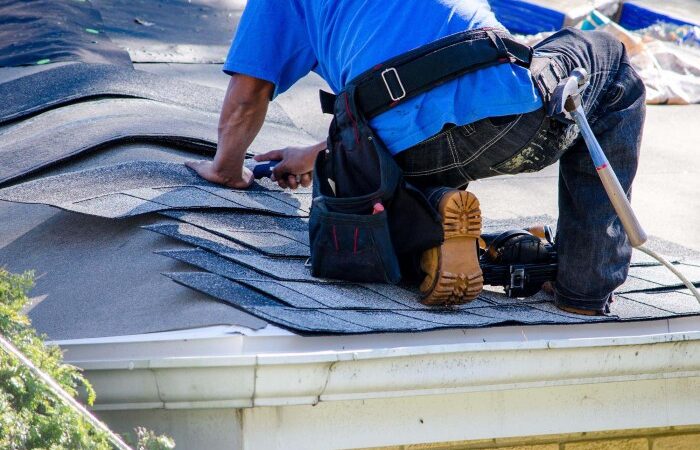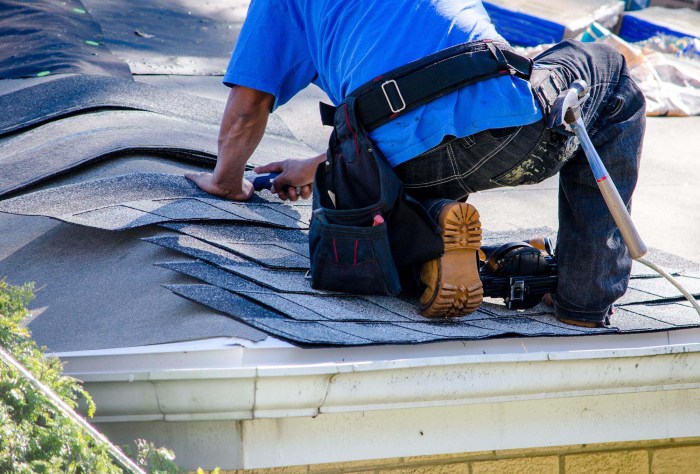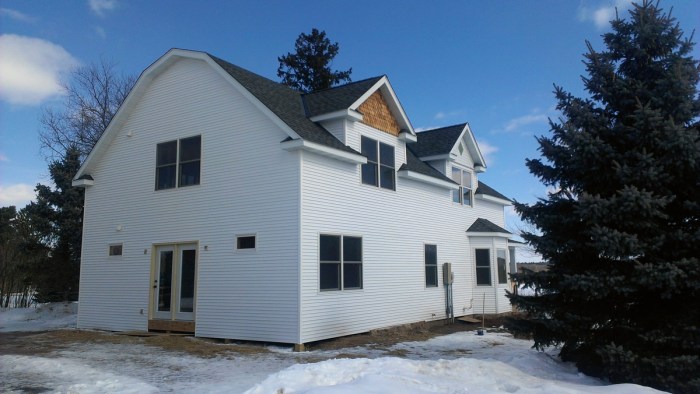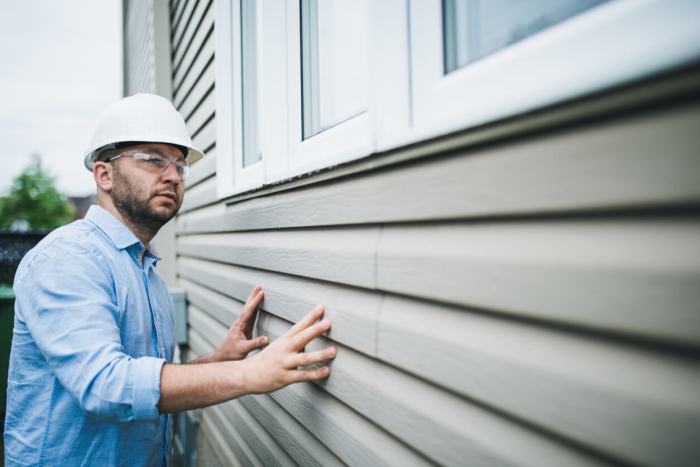Roofing and Siding Contractors Your Guide

Roofing and siding contractors are essential for maintaining and improving your home’s exterior. Choosing the right contractor can mean the difference between a smooth, successful project and a costly headache. This guide walks you through the process, from finding reputable contractors and understanding the services offered to budgeting, managing the project, and ensuring long-term satisfaction. We’ll cover everything you need to know to make informed decisions and protect your investment.
We’ll explore various roofing and siding materials, comparing their costs, lifespans, and maintenance needs. You’ll learn how to compare bids, verify licenses and insurance, and effectively communicate with your chosen contractor. We’ll also address potential project challenges and offer solutions to keep your project on track and within budget. This guide empowers you to navigate the world of home exterior renovations with confidence.
Finding Roofing and Siding Contractors

Source: superwindows.com
Finding the right roofing and siding contractor can significantly impact the longevity and value of your home. A thorough search and careful selection process are crucial to avoid costly mistakes and ensure a quality job. This section will guide you through the steps involved in finding and vetting reputable contractors.
Online Resources for Locating Contractors
Several online platforms provide access to a wide range of roofing and siding contractors. Utilizing these resources can save you considerable time and effort in your initial search. It’s recommended to check multiple platforms to broaden your options and compare contractor profiles.
- HomeAdvisor: This platform allows you to search for contractors based on location and services, and provides access to reviews and ratings from past clients.
- Angi (formerly Angie’s List): Similar to HomeAdvisor, Angi offers a comprehensive directory of contractors with customer reviews and ratings.
- Yelp: Yelp is a popular review site where you can find reviews and ratings for local businesses, including contractors.
- Google My Business: Many contractors list their business information and customer reviews on Google My Business, making it easy to find and contact them.
- Nextdoor: This neighborhood-focused social network often features recommendations and reviews from residents for various services, including home improvement.
Contractor Selection Process
Choosing a contractor involves a systematic evaluation of their qualifications and reputation. This flowchart Artikels a step-by-step process to ensure you make an informed decision.
[Flowchart Description: The flowchart would begin with “Finding Potential Contractors.” This would branch into two paths: “Check Online Reviews” and “Verify Licenses and Insurance.” “Check Online Reviews” would lead to “Positive Reviews? Yes/No.” A “Yes” would lead to “Request Bids/Proposals,” while a “No” would lead back to “Finding Potential Contractors.” “Verify Licenses and Insurance” would lead to “Licensed and Insured? Yes/No.” A “Yes” would lead to “Request Bids/Proposals,” while a “No” would lead back to “Finding Potential Contractors.” Finally, “Request Bids/Proposals” leads to “Compare Bids and Select Contractor.”]
Comparing Contractor Bids and Proposals
After receiving multiple bids, it’s essential to compare them effectively to identify the best value. Here are three methods for analyzing contractor proposals:
- Detailed Line-Item Comparison: Carefully examine each line item in the proposals to identify any discrepancies in materials, labor costs, or other expenses. This allows for a precise comparison of the total cost and individual components.
- Total Cost Analysis: While line-item comparison is crucial, don’t overlook the overall cost. Consider the total price and compare it against your budget and the scope of work.
- Value-Based Assessment: Beyond the price, consider the contractor’s reputation, experience, warranties, and the overall value they offer. A slightly higher price might be justified by superior quality and reliability.
Verifying Contractor Licenses and Insurance
Verifying a contractor’s license and insurance is paramount. This protects you from potential legal and financial liabilities. Failing to do so could leave you responsible for accidents, damages, or substandard work.
- Contact your state’s licensing board: Check the contractor’s license status and ensure it’s current and valid. Many states have online databases to verify licensing information.
- Request proof of insurance: Ask for copies of their general liability and workers’ compensation insurance certificates. Ensure the policies are active and cover the scope of the project.
- Check insurance coverage amounts: Confirm that the insurance coverage amounts are sufficient to cover potential damages or injuries.
Services Offered by Roofing and Siding Contractors

Source: roofingflorencesc.com
Roofing and siding contractors offer a wide range of services to protect and enhance your home’s exterior. From minor repairs to complete replacements, they handle everything needed to keep your property looking its best and functioning properly. Understanding the services they provide helps you make informed decisions about maintaining and improving your home’s value.
Roofing Materials Comparison
Choosing the right roofing material is a significant investment. This table compares popular options, considering lifespan, cost, and maintenance needs. Remember that actual costs can vary based on location, material availability, and labor costs.
| Roofing Material | Lifespan (Years) | Cost (Approximate Range) | Maintenance Requirements |
|---|---|---|---|
| Asphalt Shingles | 15-30 | $5,000 – $15,000 | Regular cleaning, occasional repairs |
| Tile (Clay or Concrete) | 50-100+ | $15,000 – $40,000+ | Minimal maintenance, occasional cleaning |
| Metal (Steel or Aluminum) | 50-75+ | $10,000 – $30,000+ | Low maintenance, occasional cleaning, and inspection |
Siding Options
Your siding choice impacts your home’s curb appeal, energy efficiency, and longevity. Each option presents unique advantages and disadvantages.
Vinyl Siding: Vinyl is a popular choice due to its affordability and low maintenance. It’s durable and resists moisture, but it can be susceptible to damage from impacts and extreme temperatures. It may also not be as aesthetically pleasing as other options to some homeowners.
Wood Siding: Wood siding offers a classic and natural look. It’s customizable and can be stained or painted to match any style. However, it requires more maintenance than vinyl, including regular painting and sealing to prevent rot and insect damage. It is also more expensive than vinyl.
Fiber Cement Siding: Fiber cement combines the durability of cement with the aesthetic appeal of wood. It’s resistant to fire, rot, and insects, making it a long-lasting and low-maintenance option. However, it’s more expensive than vinyl and can be more challenging to install.
Common Roofing and Siding Repair Services
Contractors provide a variety of repair services to address specific issues. These services often prevent more extensive and costly repairs down the line.
Common services include: leak repairs, shingle replacement, flashing repair, gutter cleaning and repair, siding panel replacement, caulking and sealing, and trim repair. Prompt attention to these issues extends the life of your roof and siding.
Roof Replacement vs. Roof Repair
Knowing the difference between roof replacement and repair is crucial for making the right decision.
Roof Repair addresses minor issues like a few damaged shingles or a small leak. It’s a cost-effective solution for addressing localized problems. However, if the damage is extensive or the roof is nearing the end of its lifespan, repair might not be the most economical option in the long run. For example, patching several leaks may only be a temporary fix before needing a full replacement.
Roof Replacement involves removing the entire roofing system and installing a new one. This is necessary when the roof has significant damage, is nearing the end of its lifespan, or is no longer energy-efficient. A complete replacement provides long-term protection and enhances your home’s value. For instance, if a significant portion of your shingles are damaged after a severe storm, replacement would be a better option than numerous individual repairs.
The Contracting Process
Getting your roof or siding replaced is a big undertaking, but with a clear understanding of the process, it can be smooth and stress-free. This section illustrates the typical steps involved, from the initial contact to project completion, ensuring you’re well-informed every step of the way.
The contracting process for roofing and siding projects generally follows a predictable path. A successful project relies on clear communication, detailed planning, and a well-defined contract. Let’s break down each phase to give you a better understanding.
Initial Consultation and Project Assessment
This is where it all begins. A contractor will schedule a visit to your property to assess the condition of your roof and/or siding. They will carefully examine the existing materials, identify any damage or issues, discuss your needs and preferences (style, materials, budget), and answer your questions. This initial meeting is crucial for establishing a rapport and understanding the scope of the project. Measurements are taken, photographs are often captured for documentation, and a preliminary estimate of the costs involved is provided. This stage sets the foundation for the entire project.
Proposal and Contract Development
Following the assessment, the contractor will prepare a detailed proposal outlining the scope of work, the materials to be used, the timeline for completion, and the total cost. This proposal will typically include a breakdown of labor costs, material costs, and any permits or other fees. A formal contract will then be drafted, incorporating all the details agreed upon during the consultation. This contract serves as a legally binding agreement between you and the contractor, protecting both parties.
Sample Contract Artikel
A comprehensive contract should include:
- Parties Involved: Names and contact information of the homeowner and the contractor.
- Project Description: Detailed description of the work to be performed, including specific materials and specifications.
- Payment Schedule: A clear Artikel of payment milestones, typically including a deposit upfront, progress payments during the project, and final payment upon completion.
- Timeline: Estimated start and completion dates, acknowledging potential delays due to unforeseen circumstances.
- Warranty Information: Details about the warranty offered on materials and workmanship. Typical warranties range from 1 to 25 years, depending on the product and the contractor.
- Dispute Resolution: A clause outlining the process for resolving any disputes that may arise.
- Permits and Inspections: Clarification of who is responsible for obtaining necessary permits and scheduling inspections.
Example Payment Schedule: 25% deposit upon contract signing; 25% upon completion of material delivery; 25% upon completion of roofing/siding installation; 25% final payment upon satisfactory final inspection.
Communication Strategies
Open and consistent communication is vital throughout the project. Regular updates, either through phone calls, emails, or in-person visits, can help prevent misunderstandings and ensure that the project stays on track. The contractor should be readily available to answer your questions and address any concerns. Establishing a clear communication channel right from the start is key to a positive experience.
Potential Challenges and Solutions
Unforeseen issues can arise during any construction project. For example, discovering hidden damage during demolition, material delays due to supply chain issues, or unexpected weather conditions can cause disruptions. Effective communication is key to addressing these challenges. The contractor should inform you of any problems promptly, discuss potential solutions, and work with you to find the best course of action. A well-written contract should also Artikel’s procedures for handling unforeseen circumstances and potential cost adjustments.
Project Completion and Final Inspection
Once the work is complete, a final inspection will be conducted to ensure that the project meets the specifications articulated in the contract. This inspection will involve a thorough review of the work, addressing any minor issues or touch-ups required. Upon satisfactory completion of the final inspection, the final payment is released, and the project is officially concluded. Remember to keep all documentation, including the contract, receipts, and warranty information.
Cost and Budgeting

Source: gregorycontracting.com
Planning a roofing or siding project requires careful consideration of costs. Understanding the price range for different materials and the factors influencing the overall expense is crucial for effective budgeting. This section will guide you through estimating costs, managing your budget, and exploring financing options.
Average Material Costs, Roofing and siding contractors
The cost of roofing and siding materials varies significantly depending on the chosen material, geographic location, and project complexity. Labor costs also play a significant role. The following table provides a general cost range; actual prices may differ based on your specific location and project needs. Remember to always get multiple quotes from reputable contractors.
| Material | Location A (e.g., Northeast US) | Location B (e.g., Midwest US) | Location C (e.g., Southwest US) |
|---|---|---|---|
| Asphalt Shingles | $7,000 – $15,000 | $6,000 – $12,000 | $5,000 – $10,000 |
| Wood Shakes/Shingles | $15,000 – $30,000 | $12,000 – $25,000 | $10,000 – $20,000 |
| Tile Roofing | $20,000 – $40,000 | $18,000 – $35,000 | $15,000 – $30,000 |
| Vinyl Siding | $8,000 – $18,000 | $7,000 – $15,000 | $6,000 – $12,000 |
| Fiber Cement Siding | $15,000 – $30,000 | $12,000 – $25,000 | $10,000 – $20,000 |
| Brick Siding | $25,000 – $50,000 | $20,000 – $40,000 | $18,000 – $35,000 |
Factors Influencing Project Cost
Several factors significantly impact the final cost of a roofing or siding project. These include the size and complexity of the project, the chosen materials, labor costs in your region, any necessary repairs or replacements (e.g., damaged sheathing), permits and inspections, and unforeseen issues discovered during the project. Unexpected weather delays can also add to the overall expense. For example, a large, complex Victorian home will naturally cost more than a smaller ranch-style house. Choosing high-end materials like slate roofing will also significantly increase the budget compared to standard asphalt shingles.
Budgeting Tips and Financing Options
Creating a realistic budget is crucial. Start by obtaining multiple detailed estimates from reputable contractors. Compare these estimates carefully, paying attention to the specifics of each quote. Include a contingency fund (typically 10-20% of the total estimated cost) to cover unforeseen expenses. Consider financing options like home equity loans, personal loans, or contractor financing programs. Many contractors offer payment plans to make the project more manageable. Prioritize your needs; perhaps replacing the roof is more urgent than siding, allowing you to phase the project over time.
Sample Budget Spreadsheet
A simple spreadsheet can help you track expenses. Here’s a sample structure:
| Expense Category | Estimated Cost | Actual Cost | Difference |
|---|---|---|---|
| Materials (Roofing) | |||
| Materials (Siding) | |||
| Labor (Roofing) | |||
| Labor (Siding) | |||
| Permits & Inspections | |||
| Contingency Fund | |||
| Total Project Cost |
Maintenance and Warranty

Source: woodbridgehomesolutions.com
Protecting your investment in roofing and siding goes beyond the initial installation. Regular maintenance and a thorough understanding of your warranty are crucial for ensuring the longevity and performance of these essential home components. Neglecting either can lead to costly repairs down the line.
Regular maintenance significantly extends the lifespan of your roofing and siding, preventing minor issues from escalating into major, expensive problems. Understanding your warranty protects you from unexpected expenses and ensures the contractor fulfills their obligations.
Routine Maintenance Tasks
Proper upkeep of your roofing and siding systems involves several straightforward tasks. Consistent attention to detail can prevent significant problems and save you money in the long run.
- Gutter Cleaning: Clogged gutters can lead to water damage to your roof and siding. Clean them at least twice a year, in spring and fall, removing leaves, debris, and any nests.
- Roof Inspection: At least twice a year, visually inspect your roof for missing or damaged shingles, loose flashing, or signs of leaks. Look for discoloration, curling, or buckling shingles, indicating potential problems. If you’re not comfortable inspecting the roof yourself, hire a professional.
- Siding Inspection: Regularly inspect your siding for cracks, loose panels, or signs of insect infestation. Look for any gaps or holes that could allow water intrusion. Pay close attention to areas around windows and doors.
- Trim and Flashing: Inspect the caulking around windows, doors, and chimneys. Replace any cracked or deteriorated caulking to prevent water penetration. Ensure flashing around chimneys and vents is secure and properly sealed.
- Tree and Shrub Trimming: Keep branches and shrubs trimmed away from your roof and siding. Overhanging branches can damage your roofing materials and provide a pathway for moisture to enter.
Warranty Terms and Conditions
Before signing any contract, carefully review the warranty provided by the roofing and siding contractor. Understanding the specifics of your warranty is essential for protecting your investment. Pay particular attention to the duration of the warranty, what it covers, and what it doesn’t cover. For example, some warranties might cover material defects but not labor, or vice-versa. Some warranties might have exclusions for damage caused by specific events, like severe weather. It’s best to get everything in writing.
Common Warranty Issues and Resolutions
Despite careful planning, issues can arise. Common warranty issues include material defects, faulty workmanship, or damage caused by unforeseen circumstances. If you discover a problem covered by your warranty, promptly contact your contractor. Document the issue with photos and detailed descriptions. Keep copies of all communication with the contractor, including emails, letters, and repair orders. Many warranties require you to report issues within a specific timeframe, so acting quickly is crucial. For example, if you notice a leak within the warranty period, immediately notify the contractor and provide photographic evidence of the damage and the location of the leak. Failure to promptly report issues can void your warranty.
Regular Inspection Checklist
A regular inspection checklist helps you stay on top of maintenance and catch potential problems early.
- Roof: Check for missing or damaged shingles, loose flashing, signs of leaks (staining, watermarks), and overall structural integrity.
- Siding: Inspect for cracks, loose panels, gaps, signs of insect infestation, and damage around windows and doors.
- Gutters and Downspouts: Verify proper drainage, clean out debris, and check for leaks or damage.
- Flashing: Inspect around chimneys, vents, and skylights for proper sealing and secure attachment.
- Caulking: Check caulking around windows, doors, and other areas for cracks or deterioration.
- Trees and Shrubs: Ensure branches are trimmed away from the roof and siding.
Visual Examples
Seeing is believing, and when it comes to roofing and siding, the visual impact is huge. Before-and-after photos can dramatically illustrate the improvements a new roof or siding can bring to a home’s appearance and value. Let’s explore some examples to help you visualize the potential transformation for your property.
Roof Replacement: Before and After
Imagine a house with a roof showing significant wear and tear. The shingles are curled, cracked, and missing in places. The overall color is faded and dull, with streaks of algae or moss adding to the unkempt look. Perhaps there are even some noticeable leaks or damage around the chimneys or vents. This is the “before” picture. Now, picture the same house after a complete roof replacement. The new shingles are uniformly laid, exhibiting a vibrant, consistent color. The roofline is crisp and clean, with no visible damage. The entire structure looks revitalized, showcasing a sleek, modern, or classic aesthetic depending on the shingle choice. The difference is striking, highlighting the transformative power of a new roof. The improved curb appeal is immediately noticeable, adding significant value to the property. The overall impression is one of solidity, protection, and enhanced beauty.
Siding Replacement: Before and After
Consider a house with aged, faded siding. The color might be muted and patchy, with visible signs of cracking, warping, or peeling paint. The overall impression is one of neglect and decreased curb appeal. This is the “before” scenario. After a siding replacement, the transformation is remarkable. The new siding presents a clean, uniform appearance. The chosen color is vibrant and complements the house’s architectural style. Whether it’s vinyl, fiber cement, or wood, the new siding shows off its texture and quality. The details, like trim and window surrounds, are crisp and well-defined. The house looks instantly refreshed and updated, projecting a sense of modern elegance or timeless charm, depending on the chosen material and style. The improved curb appeal significantly increases the property’s value and visual attractiveness.
Visual Characteristics of Roofing Materials
Different roofing materials offer unique visual characteristics. Asphalt shingles, for instance, come in a wide array of colors and textures, from smooth and sleek to textured and dimensional. They can mimic the look of wood shakes or slate, offering various levels of visual complexity. Tile roofs, on the other hand, often present a more uniform, but visually rich surface, with variations in color and subtle textural shifts depending on the type of tile used. Metal roofing can be smooth or textured, and often boasts a reflective quality that changes subtly depending on the light. The color palette for metal roofing is vast, ranging from traditional earth tones to modern metallic shades.
Visual Characteristics of Siding Materials
Siding materials also boast diverse visual features. Vinyl siding, for example, comes in a wide array of colors and can mimic the look of wood, brick, or stone with varying degrees of realism in its texture and grain patterns. Fiber cement siding offers a more textured, often slightly rougher appearance, closely resembling real wood or stone. Its color variations can be more subtle, yet still offer visual depth. Wood siding, when properly maintained, showcases natural grain patterns and rich color variations, contributing to a rustic or classic appeal. The texture is tactile and inviting, although it requires more maintenance than other options.
Closing Summary
Renovating your roof and siding is a significant investment, but with careful planning and the right contractor, it can dramatically enhance your home’s curb appeal, increase its value, and provide lasting protection. Remember to thoroughly research contractors, compare bids, and clearly define expectations before starting any project. By following the steps Artikel in this guide, you can ensure a positive experience and a beautiful, long-lasting result. Don’t hesitate to ask questions and advocate for your needs throughout the process.
Questions and Answers: Roofing And Siding Contractors
How long does a typical roofing or siding project take?
The timeframe varies greatly depending on the size of your home, the materials used, and the complexity of the project. Expect anywhere from a few days to several weeks.
What’s the best time of year to have roofing or siding work done?
Spring and fall are generally ideal, as extreme heat or cold can impact the work and material performance. However, the best time depends on your specific climate and contractor availability.
Can I get financing for a roofing or siding project?
Yes, many contractors offer financing options, or you can explore home improvement loans through banks or credit unions. Check with your contractor and financial institutions for available options.
What should I do if I have a problem with the completed work?
Review your contract carefully. Most contractors offer warranties. Contact your contractor immediately to discuss the issue and attempt to resolve it. If the issue isn’t resolved, you may need to explore other options like mediation or legal action.
How often should I inspect my roof and siding?
Regular inspections, ideally twice a year (spring and fall), are recommended to catch minor issues before they become major problems. Look for signs of damage, leaks, or deterioration.
Comments are closed.